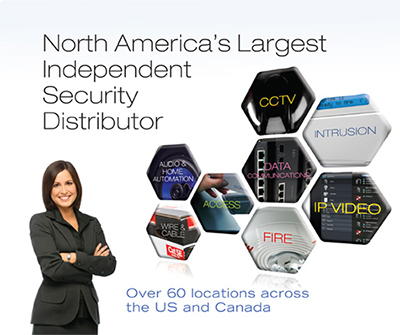It’s an understatement to say that we live in a time where top-notch security me asures are needed. Daily, we are barraged with horrific events like bombings, active shootings, etc. Fortunately, though, we have companies with the technology to deploy in order to make our lives safer.
asures are needed. Daily, we are barraged with horrific events like bombings, active shootings, etc. Fortunately, though, we have companies with the technology to deploy in order to make our lives safer.
The Tri-Ed Distribution Roadshow made a stop in Dallas, Texas last week, and I was invited to attend. I had the chance to sit in on training classes for integrators as well as mingle with companies who demonstrated and allowed me to interact with their security products and technologies. Needless to say, I learned a lot to share with you, our readers!
In fact, over the next few days, keeping with the theme of “tri,” you can expect three, information-filled articles teaching you all the valuable information that I learned during Tri-Ed’s Roadshow.
This first installment highlights Sony and Nuvico.

Sony – Going Hybrid
With technology and society changing at such a rapid pace, the security industry is fighting an ever-changing battle to create solutions that promise to deliver safety and security. One major change the security industry is experiencing is the shift from analog to IP, which is a good thing because there is no need to rip and replace wiring or cable.
Change no matter what type is hard, but Sony’s hybrid solutions take the difficulty out of this change. Sony’s hybrid, IP, 720p, mini dome camera that transmits analog and digital signals makes the analog to IP transition easier. With a built in transceiver, it’s easy to install by simply removing the old camera and adding the mini dome to an existing installation.
Sony’s IPELA Hybrid camera offers the value of an IP camera at a good price point enabling a 340 degree FOV with PTZ that is optimal for installation at the corner of a building.
Benefits of Sony’s hybrid options include:
- Lower costs;
- Reduction of installation/labor costs;
- Lower service fees;
- No additional training required because the same infrastructure is being used; and
- Environmentally friendly because the infrastructure is being re-used.
Sony understands that some integrators/customers want to wait until the time is right to shift from analog to IP, but when is the right time for this change? With Sony’s hybrid options, problems like latency, distance limitations with Ethernet cable, transmitting digital and analog into a receiver and the lower cost of migration are solved.
Also to note, Sony’s network camera lineup: E Series, X Series, V Series, PTZ and Z Series currently operate Generation 5, but Generation 6 is coming out soon to include 2nd generation Exmor CMOS sensor, enhanced visibility, wide dynamic range (WDR), dynamic noise reduction (XDNR), image stabilization and 60 fps.
By the way, integrators, Sony let us in on a little secret. The biggest market to move Sony solutions…the “sleeping giant”…retail!

Nuvico – How to Install an HD, IP System in Less Than One Hour
Step 1: Prepare
- Determine the make and model number of the router. (Tip: Use your smartphone to take a picture of the label of the customer’s router, usually on the bottom or back).
- Determine the name of customer’s ISP (Internet service provider).
Step 2: Configure
- Assign an IP address to the DVR and test local connections.
Step 3: Router (Gateway) Configuration
- Configure a LINKSYS router using gateway address, ID and password.
Note: Use www.portforward.com for FREE port forwarding tips. For example, to determine where to go to configure the router/gateway, simply choose manufacturer and model.
Step 4: Test
IP Camera Tidbits from Nuvico
- IP gives wider coverage with deeper detail.
- 2014 – Manufacturers introducing 3 and 5 megapixels.
- Complaint about IP – expensive. Remember, less IP cameras cover the same area as analog cameras.
- It's a great time to start working with IP. Become familiar with it and understand it, then you’ll be set for the future.
- Make sure you understand all licensing fees from all manufacturers that you work with so you aren’t surprised with unknown fees.
- Never run Ethernet cable over 300 feet with IP installation because data drops. If you need more than 300 feet, use a PoE extender to gain an extra 300 feet or a PoE data booster to boost up to 1000 feet.
**Stay tuned for the second installment to learn about power protection for security applications by Minuteman! Follow me on Twitter @GingerHill13 to be the first to know when the second installment goes live on our site!